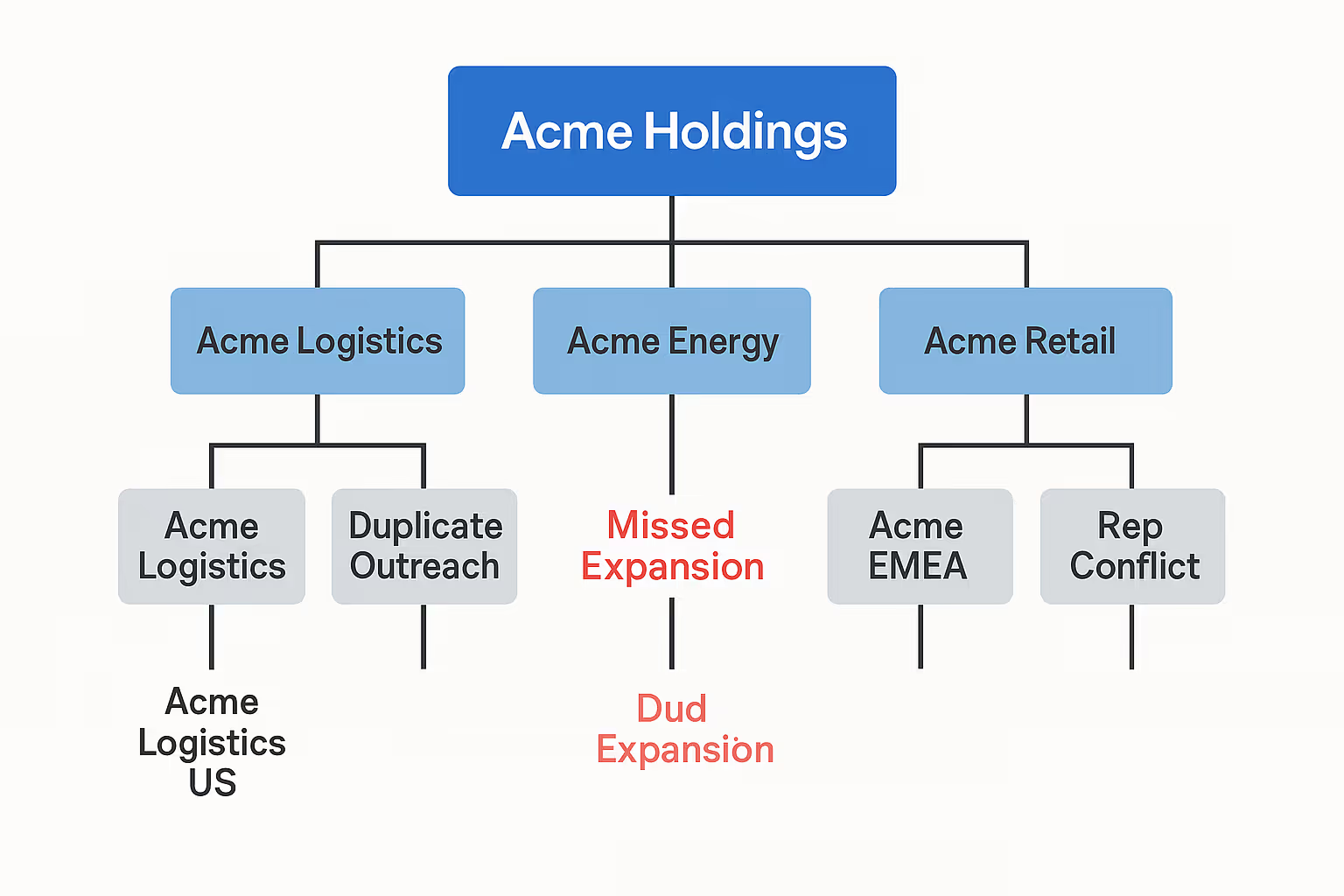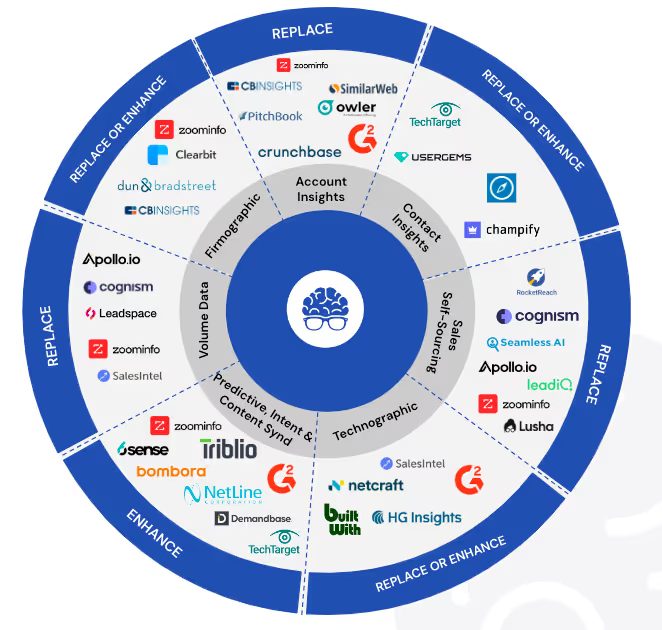When Coverage Isn’t the Problem — Misalignment Is
When go-to-market leaders talk about coverage, they talk about headcounts.
“How many accounts do we have?”
“How many contacts per account?”
“How many reps per region?”
But what if the real problem isn’t who’s missing — it’s who’s misfiled?
Buried deep in every global sales organization lies an invisible structure that quietly governs efficiency, attribution, and growth: the account hierarchy. A parent company owns five brands. Each brand runs two subsidiaries. Your CRM sees twelve accounts. Sales thinks they own the same one. Marketing hits them twice. Everyone loses.
This is the kind of dysfunction that doesn’t show up in dashboards. It shows up in friction — in the form of misaligned outreach, overlapping territories, and inflated forecasts. And it exists because most companies don’t actually know how their accounts relate to one another.
Hierarchy isn’t glamorous, but it’s foundational. It’s the connective tissue between brand and buyer, between local transaction and global ownership. And most data vendors still get it wrong.
The Hierarchy Gap
Imagine the structure of a global enterprise:
Global Parent: Acme Holdings
- Brand Divisions: Acme Logistics, Acme Energy, Acme Retail
- Subsidiaries: Acme Logistics UK, Acme Logistics US, Acme Retail EMEA
To a human, this is a simple tree. To most CRMs, it’s a forest of unlinked records.
To Dun & Bradstreet or another static database, it’s a set of disconnected identifiers.
And that’s where the gap begins.
Sales sees twelve opportunities where only one relationship exists.
Marketing targets multiple entities as if they were separate accounts.
RevOps records revenue across redundant entries, double-counting what looks like growth.
The result isn’t just inefficiency — it’s delusion. Companies believe they’re expanding when, in fact, they’re circling the same tree.
Hierarchy clarity isn’t administrative cleanup; it’s a competitive advantage.
Why Prebuilt Hierarchies Fail
Most hierarchy data wasn’t designed for modern revenue teams. It was built for the credit bureaus of the 1980s.
Dun & Bradstreet’s DUNS system is an incredible feat of recordkeeping — if your job is assessing credit risk. But it wasn’t built to mirror the way revenue moves. Ownership is only one dimension of hierarchy. Go-to-market control is another entirely — and it’s the one that actually determines where influence, authority, and buying decisions live.
There are four main reasons these prebuilt hierarchies fail the modern enterprise.
1. Static Structures in a Dynamic World
D&B updates quarterly. Your market changes weekly. Mergers, spinouts, and regional reorganizations happen faster than static datasets can refresh. The result is a lagging map of an evolving terrain.
2. Financial Logic vs. Operational Reality
Traditional hierarchies trace ownership, not control. In practice, a regional headquarters may run all EMEA operations even if it reports financially to a U.S. parent. That nuance gets flattened out in prebuilt datasets.
3. Over-Aggregation and Omission
These systems often combine or omit smaller subsidiaries, treating them as unimportant to the corporate structure. But for a sales team, the subsidiary is where the conversation starts — where the budget lives, the project begins, and the first deal closes.
4. Slow, Incomplete Coverage
Static hierarchies rely on government filings and tax records — sources that move at bureaucratic speed. They miss the new wave of digital-first businesses: remote-first, multi-brand, multi-region entities that evolve invisibly online.
The irony is that data vendors promise structure but often deliver confusion. The result is what I’d call the illusion of precision — a dataset that looks authoritative, but silently distorts the reality beneath it.
The Power of Bespoke Hierarchy Mapping
LeadGenius takes a different approach. Instead of mapping ownership alone, it builds living hierarchies that evolve in real time — the way markets actually behave.
By combining signals from corporate filings, hiring data, brand metadata, and technology infrastructure, LeadGenius reconstructs not just who owns whom, but who operates what.
- Corporate Disclosures reveal structural changes.
- Hiring Patterns show where operational control is shifting.
- Web and Brand Metadata link digital presence to physical entities.
- Technology Footprints expose shared infrastructure across subsidiaries.
- Social and Product Signals identify where new GTM initiatives emerge.
The result is a dynamic model — one that mirrors how work, purchasing power, and brand influence flow through the real world.
Why Hierarchies Define Precision
Hierarchy data isn’t for the back office anymore. It’s for the front line.
For Sales Leaders, clean hierarchies mean territory clarity — no more internal conflict over who owns which entity. Expansion plays are triggered automatically when a child entity converts.
For Marketing, it means orchestration. Campaigns can be aligned to global messaging while still personalizing by region or subsidiary. Attribution finally reflects reality.
For RevOps, it’s the difference between a forecast and a hallucination. Duplicates merge automatically, new entities are linked properly, and reporting becomes consistent across teams and systems.
For Executives, it’s transparency. When the CEO asks, “What’s our total revenue with Siemens?” the answer comes back as one clean number — not twelve disconnected fragments.
In a world obsessed with velocity, hierarchy is the structure that keeps speed from turning into chaos.
The Broader Lesson
Static data is a relic of a static economy. Dun & Bradstreet made sense when companies changed slowly and data moved slower. But today, hierarchies evolve in real time — through acquisitions, spinouts, and the fluid identities of global brands.
The future belongs to those who can see these structures clearly, in motion.
You don’t win go-to-market today by counting logos. You win by understanding relationships — by seeing not just who your customers are, but how they connect.
The truth is visual, and it’s structural.
Hierarchy clarity is revenue alignment.




